seat adjustment LINCOLN CONTINENTAL 2019 Owners Manual
[x] Cancel search | Manufacturer: LINCOLN, Model Year: 2019, Model line: CONTINENTAL, Model: LINCOLN CONTINENTAL 2019Pages: 627, PDF Size: 6.39 MB
Page 4 of 627
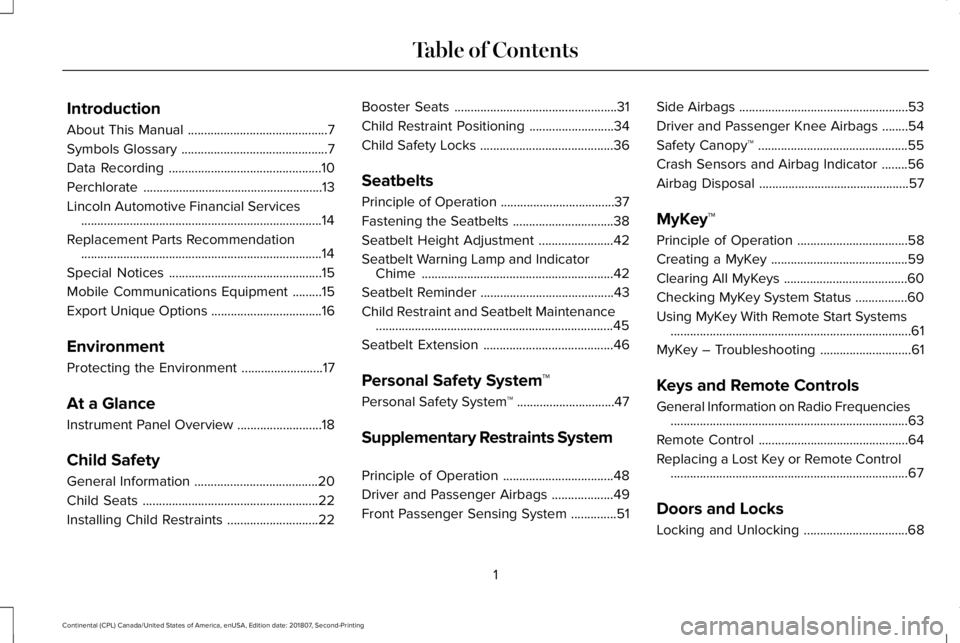
Introduction
About This Manual
...........................................7
Symbols Glossary .............................................
7
Data Recording ...............................................
10
Perchlorate .......................................................
13
Lincoln Automotive Financial Services ........................................................................\
..
14
Replacement Parts Recommendation ........................................................................\
..
14
Special Notices ...............................................
15
Mobile Communications Equipment .........
15
Export Unique Options ..................................
16
Environment
Protecting the Environment .........................
17
At a Glance
Instrument Panel Overview ..........................
18
Child Safety
General Information ......................................
20
Child Seats ......................................................
22
Installing Child Restraints ............................
22Booster Seats
..................................................
31
Child Restraint Positioning ..........................
34
Child Safety Locks .........................................
36
Seatbelts
Principle of Operation ...................................
37
Fastening the Seatbelts ...............................
38
Seatbelt Height Adjustment .......................
42
Seatbelt Warning Lamp and Indicator Chime ...........................................................
42
Seatbelt Reminder .........................................
43
Child Restraint and Seatbelt Maintenance ........................................................................\
.
45
Seatbelt Extension ........................................
46
Personal Safety System ™
Personal Safety System ™..............................
47
Supplementary Restraints System
Principle of Operation ..................................
48
Driver and Passenger Airbags ...................
49
Front Passenger Sensing System ..............
51Side Airbags
....................................................
53
Driver and Passenger Knee Airbags ........
54
Safety Canopy™ ..............................................
55
Crash Sensors and Airbag Indicator ........
56
Airbag Disposal ..............................................
57
MyKey™
Principle of Operation ..................................
58
Creating a MyKey ..........................................
59
Clearing All MyKeys ......................................
60
Checking MyKey System Status ................
60
Using MyKey With Remote Start Systems ........................................................................\
..
61
MyKey – Troubleshooting ............................
61
Keys and Remote Controls
General Information on Radio Frequencies ........................................................................\
.
63
Remote Control ..............................................
64
Replacing a Lost Key or Remote Control ........................................................................\
.
67
Doors and Locks
Locking and Unlocking ................................
68
1
Continental (CPL) Canada/United States of America, enUSA, Edition date: 201807, Second-Printing Table of Contents
Page 42 of 627
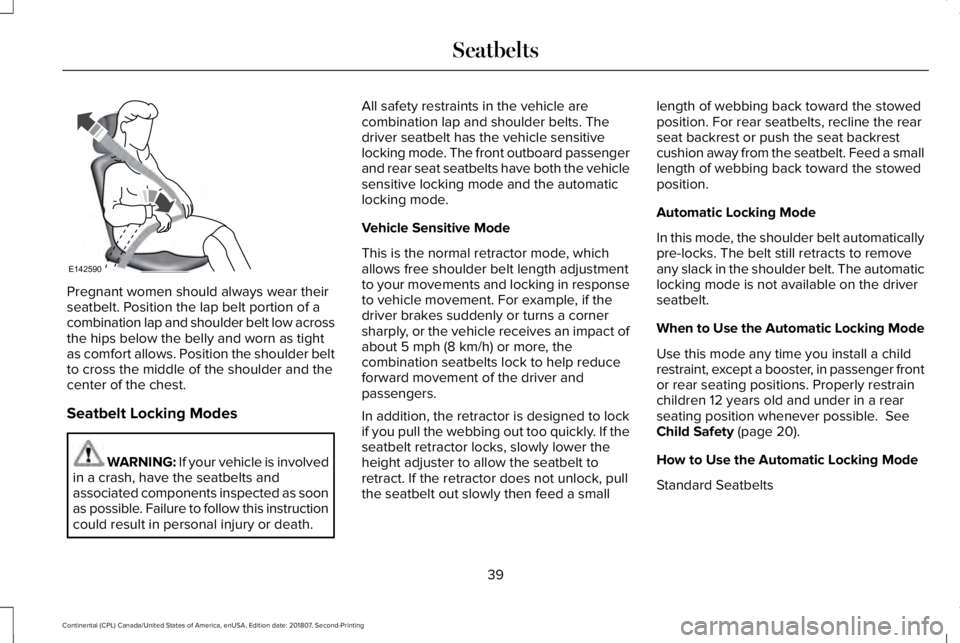
Pregnant women should always wear their
seatbelt. Position the lap belt portion of a
combination lap and shoulder belt low across
the hips below the belly and worn as tight
as comfort allows. Position the shoulder belt
to cross the middle of the shoulder and the
center of the chest.
Seatbelt Locking Modes
WARNING: If your vehicle is involved
in a crash, have the seatbelts and
associated components inspected as soon
as possible. Failure to follow this instruction
could result in personal injury or death. All safety restraints in the vehicle are
combination lap and shoulder belts. The
driver seatbelt has the vehicle sensitive
locking mode. The front outboard passenger
and rear seat seatbelts have both the vehicle
sensitive locking mode and the automatic
locking mode.
Vehicle Sensitive Mode
This is the normal retractor mode, which
allows free shoulder belt length adjustment
to your movements and locking in response
to vehicle movement. For example, if the
driver brakes suddenly or turns a corner
sharply, or the vehicle receives an impact of
about 5 mph (8 km/h) or more, the
combination seatbelts lock to help reduce
forward movement of the driver and
passengers.
In addition, the retractor is designed to lock
if you pull the webbing out too quickly. If the
seatbelt retractor locks, slowly lower the
height adjuster to allow the seatbelt to
retract. If the retractor does not unlock, pull
the seatbelt out slowly then feed a small length of webbing back toward the stowed
position. For rear seatbelts, recline the rear
seat backrest or push the seat backrest
cushion away from the seatbelt. Feed a small
length of webbing back toward the stowed
position.
Automatic Locking Mode
In this mode, the shoulder belt automatically
pre-locks. The belt still retracts to remove
any slack in the shoulder belt. The automatic
locking mode is not available on the driver
seatbelt.
When to Use the Automatic Locking Mode
Use this mode any time you install a child
restraint, except a booster, in passenger front
or rear seating positions. Properly restrain
children 12 years old and under in a rear
seating position whenever possible.
See
Child Safety (page 20).
How to Use the Automatic Locking Mode
Standard Seatbelts
39
Continental (CPL) Canada/United States of America, enUSA, Edition date: 201807, Second-Printing SeatbeltsE142590
Page 45 of 627
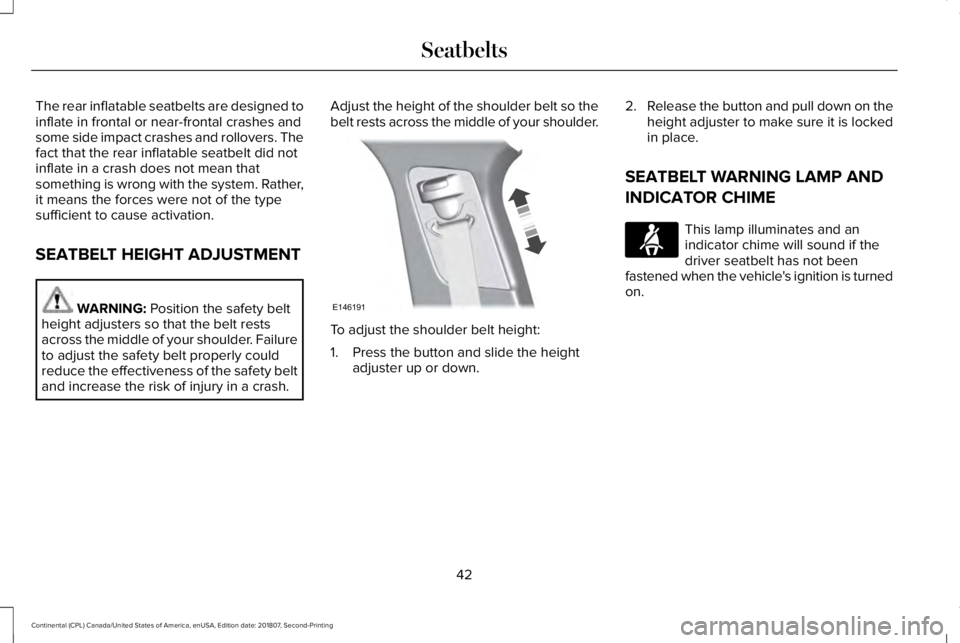
The rear inflatable seatbelts are designed to
inflate in frontal or near-frontal crashes and
some side impact crashes and rollovers. The
fact that the rear inflatable seatbelt did not
inflate in a crash does not mean that
something is wrong with the system. Rather,
it means the forces were not of the type
sufficient to cause activation.
SEATBELT HEIGHT ADJUSTMENT
WARNING: Position the safety belt
height adjusters so that the belt rests
across the middle of your shoulder. Failure
to adjust the safety belt properly could
reduce the effectiveness of the safety belt
and increase the risk of injury in a crash. Adjust the height of the shoulder belt so the
belt rests across the middle of your shoulder.
To adjust the shoulder belt height:
1. Press the button and slide the height
adjuster up or down. 2.
Release the button and pull down on the
height adjuster to make sure it is locked
in place.
SEATBELT WARNING LAMP AND
INDICATOR CHIME This lamp illuminates and an
indicator chime will sound if the
driver seatbelt has not been
fastened when the vehicle's ignition is turned
on.
42
Continental (CPL) Canada/United States of America, enUSA, Edition date: 201807, Second-Printing SeatbeltsE146191 E71880
Page 53 of 627
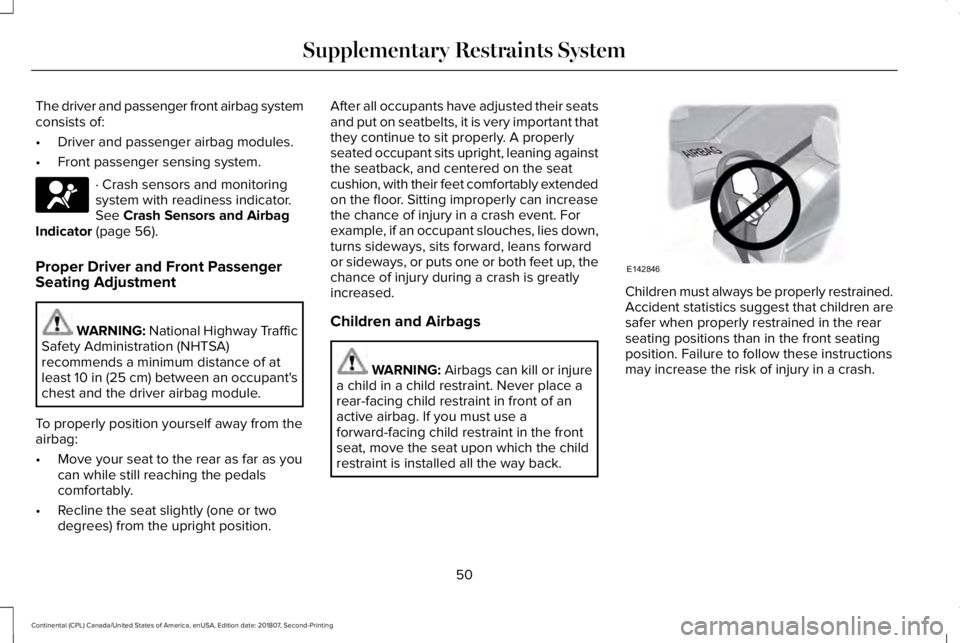
The driver and passenger front airbag system
consists of:
•
Driver and passenger airbag modules.
• Front passenger sensing system. · Crash sensors and monitoring
system with readiness indicator.
See Crash Sensors and Airbag
Indicator (page 56).
Proper Driver and Front Passenger
Seating Adjustment WARNING:
National Highway Traffic
Safety Administration (NHTSA)
recommends a minimum distance of at
least
10 in (25 cm) between an occupant's
chest and the driver airbag module.
To properly position yourself away from the
airbag:
• Move your seat to the rear as far as you
can while still reaching the pedals
comfortably.
• Recline the seat slightly (one or two
degrees) from the upright position. After all occupants have adjusted their seats
and put on seatbelts, it is very important that
they continue to sit properly. A properly
seated occupant sits upright, leaning against
the seatback, and centered on the seat
cushion, with their feet comfortably extended
on the floor. Sitting improperly can increase
the chance of injury in a crash event. For
example, if an occupant slouches, lies down,
turns sideways, sits forward, leans forward
or sideways, or puts one or both feet up, the
chance of injury during a crash is greatly
increased.
Children and Airbags
WARNING: Airbags can kill or injure
a child in a child restraint. Never place a
rear-facing child restraint in front of an
active airbag. If you must use a
forward-facing child restraint in the front
seat, move the seat upon which the child
restraint is installed all the way back. Children must always be properly restrained.
Accident statistics suggest that children are
safer when properly restrained in the rear
seating positions than in the front seating
position. Failure to follow these instructions
may increase the risk of injury in a crash.
50
Continental (CPL) Canada/United States of America, enUSA, Edition date: 201807, Second-Printing Supplementary Restraints SystemE67017 E142846
Page 125 of 627
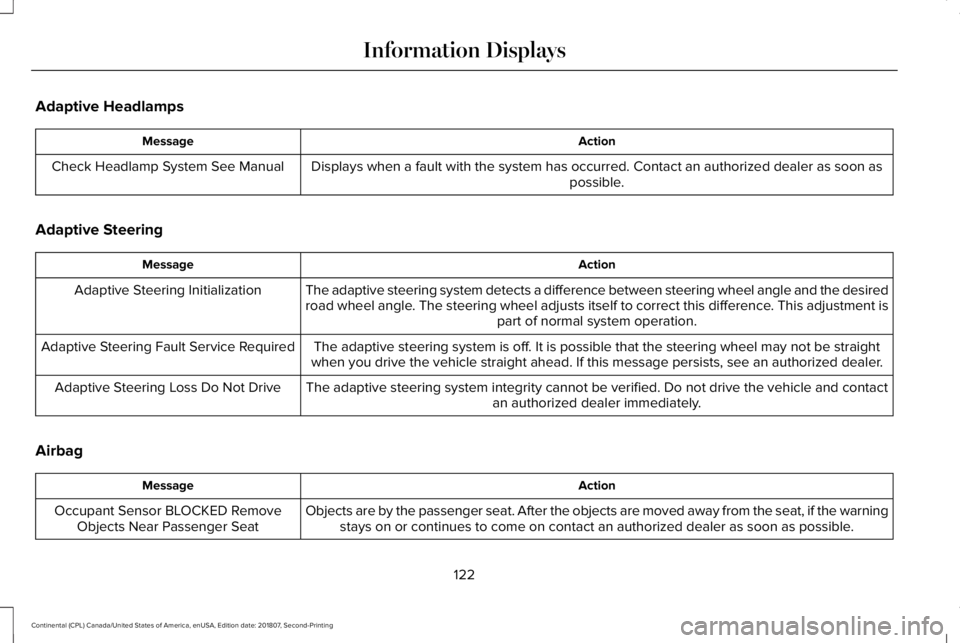
Adaptive Headlamps
Action
Message
Displays when a fault with the system has occurred. Contact an authorize\
d dealer as soon as possible.
Check Headlamp System See Manual
Adaptive Steering Action
Message
The adaptive steering system detects a difference between steering wheel\
angle and the desired
road wheel angle. The steering wheel adjusts itself to correct this difference. This adjustment is part of normal system operation.
Adaptive Steering Initialization
The adaptive steering system is off. It is possible that the steering wheel may not be straight
when you drive the vehicle straight ahead. If this message persists, see\
an authorized dealer.
Adaptive Steering Fault Service Required
The adaptive steering system integrity cannot be verified. Do not drive \
the vehicle and contactan authorized dealer immediately.
Adaptive Steering Loss Do Not Drive
Airbag Action
Message
Objects are by the passenger seat. After the objects are moved away from\
the seat, if the warningstays on or continues to come on contact an authorized dealer as soon as\
possible.
Occupant Sensor BLOCKED Remove
Objects Near Passenger Seat
122
Continental (CPL) Canada/United States of America, enUSA, Edition date: 201807, Second-Printing Information Displays
Page 151 of 627
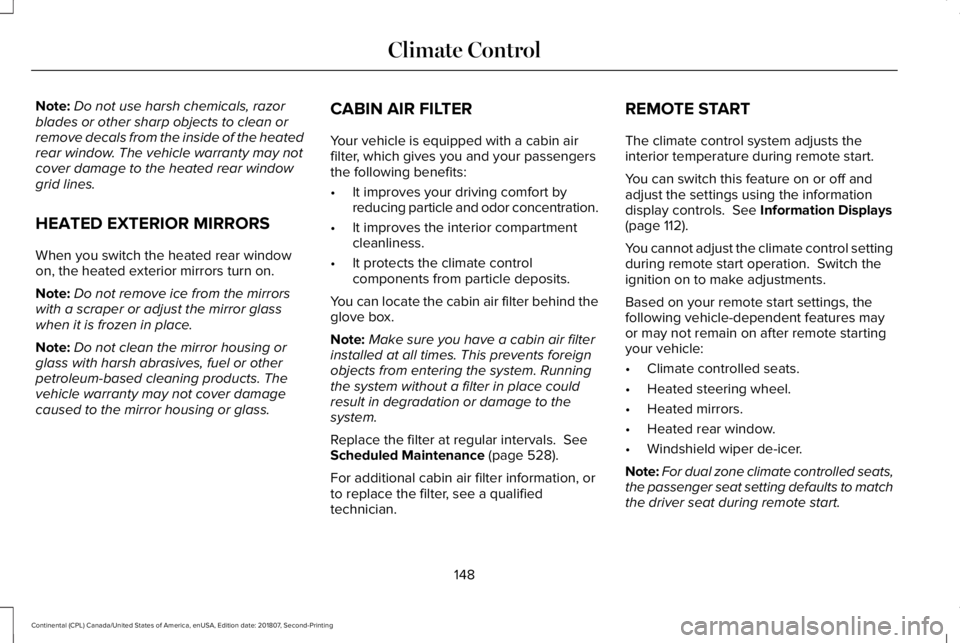
Note:
Do not use harsh chemicals, razor
blades or other sharp objects to clean or
remove decals from the inside of the heated
rear window. The vehicle warranty may not
cover damage to the heated rear window
grid lines.
HEATED EXTERIOR MIRRORS
When you switch the heated rear window
on, the heated exterior mirrors turn on.
Note: Do not remove ice from the mirrors
with a scraper or adjust the mirror glass
when it is frozen in place.
Note: Do not clean the mirror housing or
glass with harsh abrasives, fuel or other
petroleum-based cleaning products. The
vehicle warranty may not cover damage
caused to the mirror housing or glass. CABIN AIR FILTER
Your vehicle is equipped with a cabin air
filter, which gives you and your passengers
the following benefits:
•
It improves your driving comfort by
reducing particle and odor concentration.
• It improves the interior compartment
cleanliness.
• It protects the climate control
components from particle deposits.
You can locate the cabin air filter behind the
glove box.
Note: Make sure you have a cabin air filter
installed at all times. This prevents foreign
objects from entering the system. Running
the system without a filter in place could
result in degradation or damage to the
system.
Replace the filter at regular intervals. See
Scheduled Maintenance (page 528).
For additional cabin air filter information, or
to replace the filter, see a qualified
technician. REMOTE START
The climate control system adjusts the
interior temperature during remote start.
You can switch this feature on or off and
adjust the settings using the information
display controls.
See Information Displays
(page 112).
You cannot adjust the climate control setting
during remote start operation. Switch the
ignition on to make adjustments.
Based on your remote start settings, the
following vehicle-dependent features may
or may not remain on after remote starting
your vehicle:
• Climate controlled seats.
• Heated steering wheel.
• Heated mirrors.
• Heated rear window.
• Windshield wiper de-icer.
Note: For dual zone climate controlled seats,
the passenger seat setting defaults to match
the driver seat during remote start.
148
Continental (CPL) Canada/United States of America, enUSA, Edition date: 201807, Second-Printing Climate Control
Page 157 of 627
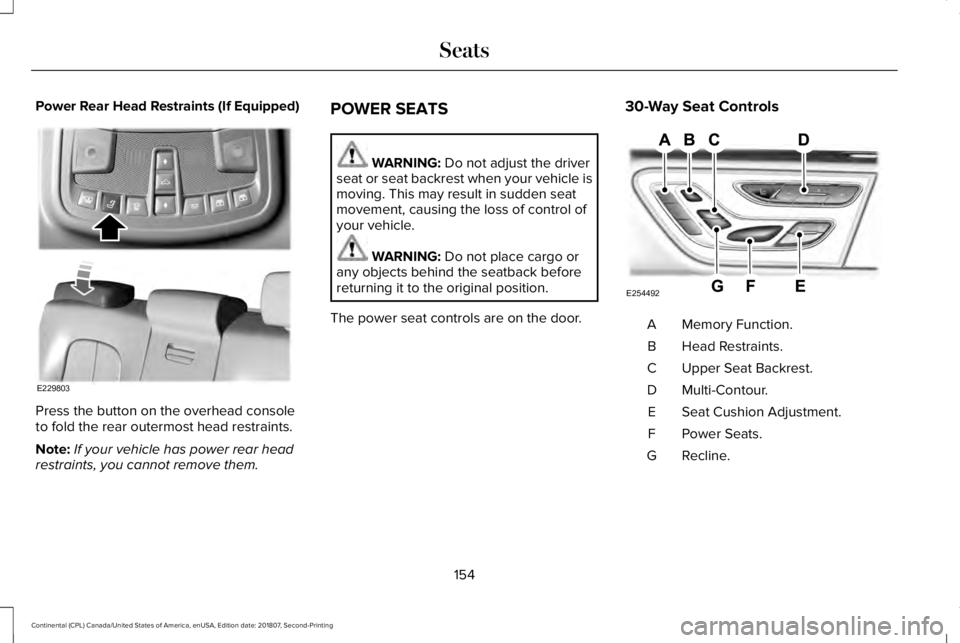
Power Rear Head Restraints (If Equipped)
Press the button on the overhead console
to fold the rear outermost head restraints.
Note:
If your vehicle has power rear head
restraints, you cannot remove them. POWER SEATS WARNING: Do not adjust the driver
seat or seat backrest when your vehicle is
moving. This may result in sudden seat
movement, causing the loss of control of
your vehicle. WARNING:
Do not place cargo or
any objects behind the seatback before
returning it to the original position.
The power seat controls are on the door. 30-Way Seat Controls Memory Function.
A
Head Restraints.
B
Upper Seat Backrest.
C
Multi-Contour.
D
Seat Cushion Adjustment.
E
Power Seats.
F
Recline.
G
154
Continental (CPL) Canada/United States of America, enUSA, Edition date: 201807, Second-Printing SeatsE229803 E254492
Page 163 of 627
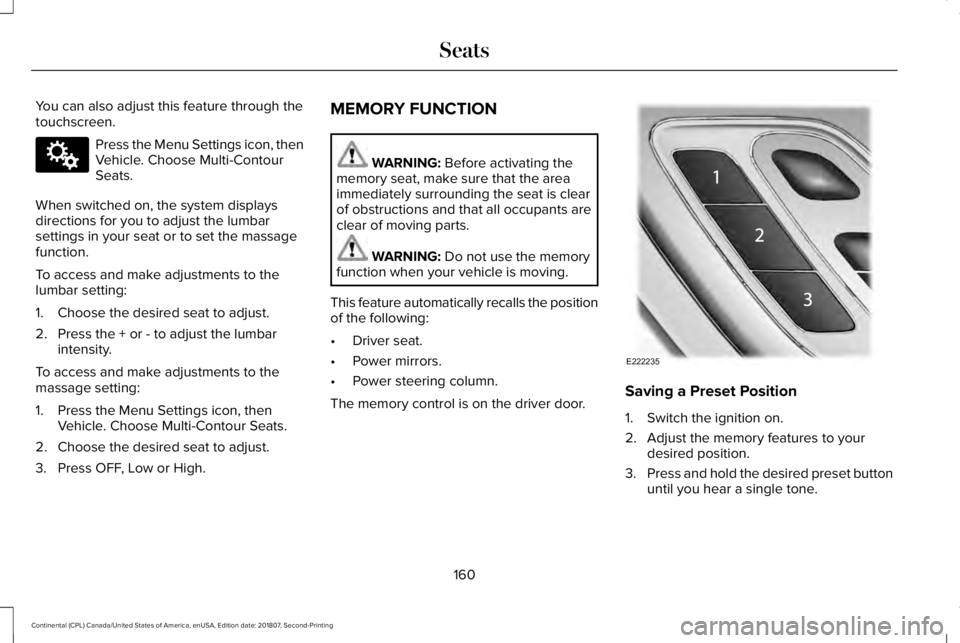
You can also adjust this feature through the
touchscreen.
Press the Menu Settings icon, then
Vehicle. Choose Multi-Contour
Seats.
When switched on, the system displays
directions for you to adjust the lumbar
settings in your seat or to set the massage
function.
To access and make adjustments to the
lumbar setting:
1. Choose the desired seat to adjust.
2. Press the + or - to adjust the lumbar intensity.
To access and make adjustments to the
massage setting:
1. Press the Menu Settings icon, then Vehicle. Choose Multi-Contour Seats.
2. Choose the desired seat to adjust.
3. Press OFF, Low or High. MEMORY FUNCTION WARNING: Before activating the
memory seat, make sure that the area
immediately surrounding the seat is clear
of obstructions and that all occupants are
clear of moving parts. WARNING:
Do not use the memory
function when your vehicle is moving.
This feature automatically recalls the position
of the following:
• Driver seat.
• Power mirrors.
• Power steering column.
The memory control is on the driver door. Saving a Preset Position
1. Switch the ignition on.
2. Adjust the memory features to your
desired position.
3. Press and hold the desired preset button
until you hear a single tone.
160
Continental (CPL) Canada/United States of America, enUSA, Edition date: 201807, Second-Printing SeatsE142607 E222235
Page 164 of 627
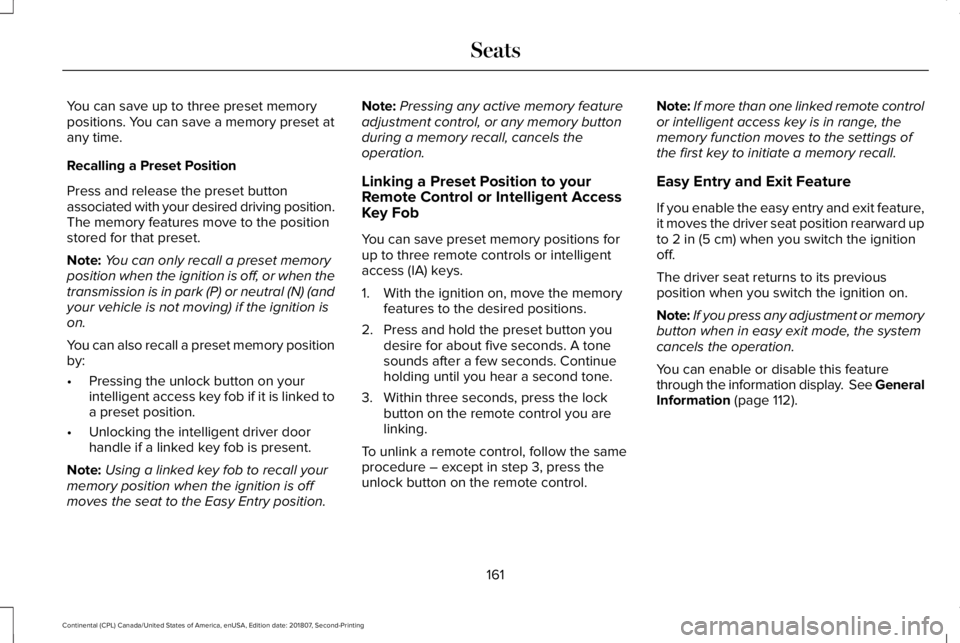
You can save up to three preset memory
positions. You can save a memory preset at
any time.
Recalling a Preset Position
Press and release the preset button
associated with your desired driving position.
The memory features move to the position
stored for that preset.
Note:
You can only recall a preset memory
position when the ignition is off, or when the
transmission is in park (P) or neutral (N) (and
your vehicle is not moving) if the ignition is
on.
You can also recall a preset memory position
by:
• Pressing the unlock button on your
intelligent access key fob if it is linked to
a preset position.
• Unlocking the intelligent driver door
handle if a linked key fob is present.
Note: Using a linked key fob to recall your
memory position when the ignition is off
moves the seat to the Easy Entry position. Note:
Pressing any active memory feature
adjustment control, or any memory button
during a memory recall, cancels the
operation.
Linking a Preset Position to your
Remote Control or Intelligent Access
Key Fob
You can save preset memory positions for
up to three remote controls or intelligent
access (IA) keys.
1. With the ignition on, move the memory features to the desired positions.
2. Press and hold the preset button you desire for about five seconds. A tone
sounds after a few seconds. Continue
holding until you hear a second tone.
3. Within three seconds, press the lock button on the remote control you are
linking.
To unlink a remote control, follow the same
procedure – except in step 3, press the
unlock button on the remote control. Note:
If more than one linked remote control
or intelligent access key is in range, the
memory function moves to the settings of
the first key to initiate a memory recall.
Easy Entry and Exit Feature
If you enable the easy entry and exit feature,
it moves the driver seat position rearward up
to 2 in (5 cm) when you switch the ignition
off.
The driver seat returns to its previous
position when you switch the ignition on.
Note: If you press any adjustment or memory
button when in easy exit mode, the system
cancels the operation.
You can enable or disable this feature
through the information display. See General
Information
(page 112).
161
Continental (CPL) Canada/United States of America, enUSA, Edition date: 201807, Second-Printing Seats
Page 617 of 627
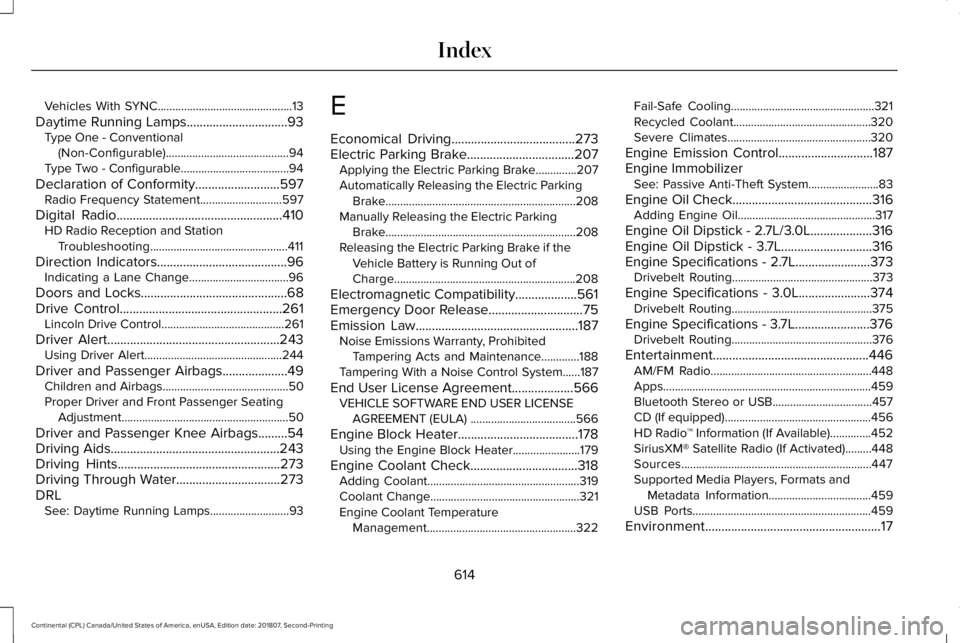
Vehicles With SYNC..............................................13
Daytime Running Lamps...............................93 Type One - Conventional
(Non-Configurable)..........................................94
Type Two - Configurable.....................................94
Declaration of Conformity..........................597
Radio Frequency Statement............................597
Digital Radio
...................................................410
HD Radio Reception and Station
Troubleshooting...............................................411
Direction Indicators
........................................96
Indicating a Lane Change..................................96
Doors and Locks.............................................68
Drive Control
..................................................261
Lincoln Drive Control..........................................261
Driver Alert
.....................................................243
Using Driver Alert...............................................244
Driver and Passenger Airbags....................49 Children and Airbags...........................................50
Proper Driver and Front Passenger Seating
Adjustment .........................................................50
Driver and Passenger Knee Airbags.........54
Driving Aids
....................................................243
Driving Hints..................................................273
Driving Through Water................................273
DRL See: Daytime Running Lamps...........................93 E
Economical Driving
......................................273
Electric Parking Brake.................................207 Applying the Electric Parking Brake..............207
Automatically Releasing the Electric Parking
Brake.................................................................208
Manually Releasing the Electric Parking Brake.................................................................208
Releasing the Electric Parking Brake if the Vehicle Battery is Running Out of
Charge..............................................................208
Electromagnetic Compatibility
...................561
Emergency Door Release.............................75
Emission Law..................................................187 Noise Emissions Warranty, Prohibited
Tampering Acts and Maintenance.............188
Tampering With a Noise Control System......187
End User License Agreement...................566 VEHICLE SOFTWARE END USER LICENSE
AGREEMENT (EULA) ....................................566
Engine Block Heater
.....................................178
Using the Engine Block Heater.......................179
Engine Coolant Check.................................318 Adding Coolant....................................................319
Coolant Change...................................................321
Engine Coolant Temperature
Management...................................................322 Fail-Safe Cooling.................................................321
Recycled Coolant...............................................320
Severe Climates.................................................320
Engine Emission Control.............................187
Engine Immobilizer See: Passive Anti-Theft System........................83
Engine Oil Check...........................................316 Adding Engine Oil...............................................317
Engine Oil Dipstick - 2.7L/3.0L...................316
Engine Oil Dipstick - 3.7L............................316
Engine Specifications - 2.7L.......................373 Drivebelt Routing................................................373
Engine Specifications - 3.0L......................374 Drivebelt Routing................................................375
Engine Specifications - 3.7L.......................376 Drivebelt Routing................................................376
Entertainment................................................446 AM/FM Radio.......................................................448
Apps.......................................................................459
Bluetooth Stereo or USB..................................457
CD (If equipped)..................................................456
HD Radio ™ Information (If Available)..............452
SiriusXM® Satellite Radio (If Activated).........448
Sources.................................................................447
Supported Media Players, Formats and Metadata Information...................................459
USB Ports.............................................................459
Environment......................................................17
614
Continental (CPL) Canada/United States of America, enUSA, Edition date: 201807, Second-Printing Index